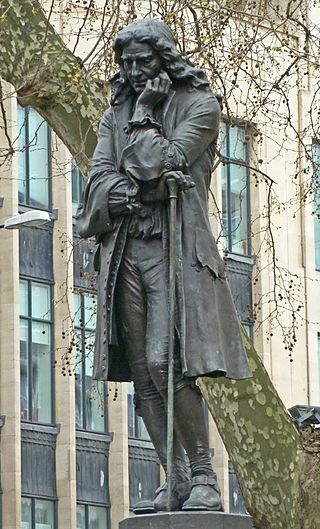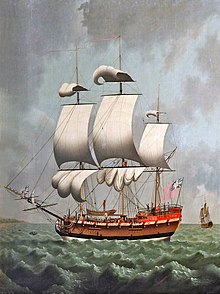
Bristol, a port city in south-west England, was involved in the transatlantic slave trade. Bristol's part in the trade was prominent in the 17th and 18th centuries as the city's merchants used their position to gain involvement. It is estimated that over 500,000 enslaved African people were traded by Bristol merchants.
Othello was launched in 1786 at Liverpool for the African slave trade. She made some five voyages before she burnt off the coast of Africa in 1796. During her first voyage her master fired on another British slave ship, which gave rise to an interesting court case. As a letter of marque she recaptured a British ship in 1794.
Little Ephraim Robin John and Ancona Robin Robin John were two 18th century African slave traders, later slaves, and finally free men who were members of the ruling family of Old Town, Calabur, Nigeria. Ancona was either a son or nephew of Little Ephraim.
Prince was launched at Bristol in 1785 as Alexander and then made two complete voyages as a slave ship in the triangular trade in enslaved people. Her owners changed her name to Prince in 1787. As Prince, she made six more complete voyages as an enslaving ship. She sailed on enslaving voyages for owners in Bristol, Liverpool, and London. She foundered in 1800 as she was returning to England from her ninth, having delivered captives to Jamaica.

George Case (1747–1836) was a British slave trader who was responsible for at least 109 slave voyages. Case was the co-owner of the slave ship Zong, whose crew perpetrated the Zong massacre. After the massacre, the ship owners went to court in an attempt to secure an insurance payout of £30 for each enslaved person murdered. A public outcry ensued and strengthened the abolition movement in the United Kingdom. In 1781, he became Mayor of Liverpool. After he died, the wealth generated by his slavery was bequeathed to the Case Fund by his grandson.
William Davenport was a British slave trader who was, by the number of ships disembarked, the single most prolific slave trader from the Port of Liverpool. He took part in 163 slaving voyages and his slave ships carried almost 40,000 enslaved Africans.
Amacree or Amachree, was launched in 1788 in Liverpool. She made ten voyages as a slave ship in the triangular trade, carrying enslaved people from West Africa and primarily to Dominica. On her fourth such voyage, she and five other slave ships bombarded Calabar for more than three hours to force the local native traders to lower the prices they were charging for slaves. The last press mention of Amacree occurred in 1801.

William Gregson was a British slave trader. He was responsible for at least 152 slave voyages, and his slave ships are recorded as having carried 58,201 Africans, of whom 9,148 died. Gregson was the co-owner of a ship called the Zong, whose crew perpetrated the Zong massacre.

Thomas Leyland (1752–1827) was an English slave trader. In 1776, he won a lottery and with his share of the winnings, he set himself up in the slave trade. Leyland bought at least 22,365 enslaved Africans and took them on his slave ships to the Americas.
Ralph Fisher (1746–1803) was an English slave trader based in Liverpool who was responsible for over 100 slave voyages. He is said to have been the seventh-biggest slave trader in Liverpool.
Francis Ingram (1739–1815) was an English slave trader and privateer.

William Earle (1721–1788) was an English slave trader. In a career lasting 40 years he was responsible for at least 117 slave voyages and by the number of slave voyages he was the sixth most active slave trader in the period 1740–1790 from the Port of Liverpool.
Liverpool, a port city in north-west England, was involved in the transatlantic slave trade. The trade developed in the eighteenth century, as Liverpool slave traders were able to supply fabric from Manchester to the Caribbean islands at very competitive prices.

Thomas Earle (1754–1822) was an English slave trader. He was responsible for at least 73 slave voyages and alongside his brother he transported over 19,000 enslaved people. Of these 3,000 died on board his ships. One of his ships, Annabella, was seized by the British Crown for slave trading with the enemy. He was Mayor of Liverpool in 1787.

John Knight (1708–1774) was an English slave trader. He was responsible for at least 114 slave voyages in the period 1750–1775 and he transported over 26,000 Africans to the Americas. Knight traded enslaved Africans with the American politician and slave owner Henry Laurens.
Samuel Shaw (1718–1781) was an English slave trader. He was responsible for at least 119 slave voyages between 1750 and 1778.

Felix Doran (1708–1776) was an Irish slave trader. He was responsible for at least 69 slave voyages. Doran moved to Liverpool in the 1740s and operated out of the Port of Liverpool. His first slave-ship was called Lively and his final one was called Essex.

Thomas Foxcroft (1733–1809) was an English slave trader. He was responsible for at least 91 slave voyages in the years between 1759 and 1792. A contemporary set of financial accounts for one slave voyage by his slave-ship Bloom has been preserved. Captain Robert Bostock, Bloom's master, bought 349 enslaved people in Africa; 42 captives died and 307 captives were sold in the West Indies for £9858. The net profit on the voyage to the owners amounted to £8,123 7s 2d, or £26 9s 2d per captive sold.

Edward Parr was an English slave trader and merchant. He was involved in 51 slave voyages, operating out of the Port of Liverpool between 1750 and 1768. Parr owned a slave ship called Briton, whose captain employed an African pirate called Captain Lemma Lemma to capture and enslave people with his war canoes. Parr was a member of the African Company of Merchants.
Liverpool Hero was built in France in 1777, probably as Jeune Emilia. She was taken in prize in 1780. In 1781 she entered into the triangular trade in enslaved people. From 1781 she made six complete voyages from Liverpool as a slave ship. On her fourth enslaving voyage she suffered an exceptionally high mortality rate among the captives she had embarked. Her third voyage had been marred by high mortality, but on the fourth 330 captives, 59% of the number she had embarked, died. She was lost in 1794 off the coast of Africa on her seventh voyage, probably with her crew and captives.









